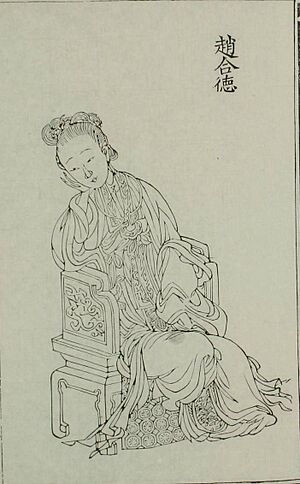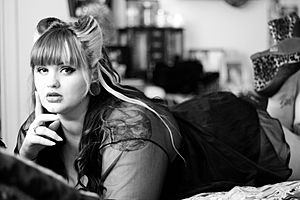Body image facts for kids

Body image is how a person sees and feels about their own body. It's like a picture you have in your mind of what you look like.
This picture can be positive or negative. If you have a negative body image, you might feel shy or ashamed of your body. You might also think others look better than you. Today, social media plays a big role in our lives. It can make people of all ages feel worried about their looks. This is because society often sets ideas about how bodies should look. These ideas can lead to body shaming, which is when people criticize their own or others' bodies.
When people have a negative body image, they might have low self-esteem. They might also focus too much on changing their appearance. This can lead to feeling unhappy with their body. It can also increase the risk of eating disorders or other mental illnesses. People with a low body image sometimes try to change their bodies. They might go on diets or consider cosmetic surgery.
On the other hand, a positive body image means you see your body clearly. You appreciate and celebrate your body. You also understand that your looks do not show your true worth or character. Many things can affect your body image. These include your family, your health, and what society expects. For example, what you see in the media can play a big part.
How Body Image Ideas Changed Over Time



Ideas about the "perfect" body have changed a lot through history. In Ancient Egypt, the ideal woman was slender. She had narrow shoulders and a tall waist. Ancient Greece focused more on the male body. But their ideal woman was full-figured and plump. She also had fair skin.
In Han Dynasty China, people cared most about the face, skin, and hair. Clear, white skin and long, dark hair were seen as beautiful. For men, a strong body was ideal. Any feature that showed wealth or high social status was also admired.
During the Italian Renaissance, a wife's looks showed her husband's status. Being larger was linked to wealth. So, the ideal wife had wide hips and a full chest. The Victorian Era also liked a fuller figure. But the popular corset made the "hourglass" shape very desirable. In the early 1900s, the U.S. fashion world loved the Gibson Girl. She was tall and slim, with a big bust, wide hips, and a tiny waist.
After World War I, the Gibson Girl changed into the Flapper. This look was popular in the "Roaring Twenties". Women started to prefer more androgynous (less feminine) styles. Hair was kept short, and bras were worn to flatten the chest. Clothes also became more casual. This might have shown a relaxed mood after the war. Advertisements started to push for thinner bodies. Many women began to diet and exercise. Even though slimmer bodies were liked, a sporty and healthy look was still preferred. It was better than the frail look from the Victorian Era.
In 1935, a doctor named Paul Schilder wrote a book. In it, he first used the term 'body-image'.
The 1930s and 1940s saw World War II. While men were fighting, women joined the workforce. This led to more formal military-style clothes for women. This also changed body image ideas. Waists stayed thin but noticeable. The media started to like a more curvy, hourglass figure look. This was also the golden age of Hollywood. Many movie stars like Marilyn Monroe and Sophia Loren wore tight clothes. They showed off their curvy figures, which influenced this trend.
From the 1960s onwards, the ideal woman slowly became thinner. The "Swinging Sixties" brought back a look similar to the Flapper. This was seen with model Twiggy. She promoted a very thin and small body. She had long, slender legs and a young, androgynous figure. Other features included narrow hips and flat stomachs. Many women went on diets or took weight-loss pills to get this new look. This led to more cases of anorexia nervosa in the 1970s.
Later, being fit became more important. Actress Farrah Fawcett showed off a more toned and athletic body. The exercise trend grew in the 1980s with Jane Fonda. Her workout videos encouraged women to be thin but also strong and graceful. This time also saw the rise of tall, long-legged supermodels. Names like Naomi Campbell and Cindy Crawford set new beauty standards worldwide.
In the 1990s, supermodel Kate Moss made the very thin figure popular. This was called the "waif" look. It meant having a bony, thin body with thin limbs and an androgynous shape.
Since 2017, there have been efforts to promote a better body image. This includes focusing on fitness and using plus-size models in fashion. However, new technologies and media pressure still make us focus a lot on how we look. This can make us feel that our looks show our personal worth.
A study by Dove found that only 4% of women thought they were beautiful. About 70% of women and girls in the UK felt that media's unrealistic beauty standards made them worried about their looks. Because of this, the U.S. Department of Health and Human Services reported that 91% of women were mostly unhappy with their bodies. Also, 40% would think about cosmetic surgery to "fix" their flaws.
Related pages
See also
 In Spanish: Percepción corporal para niños
In Spanish: Percepción corporal para niños


